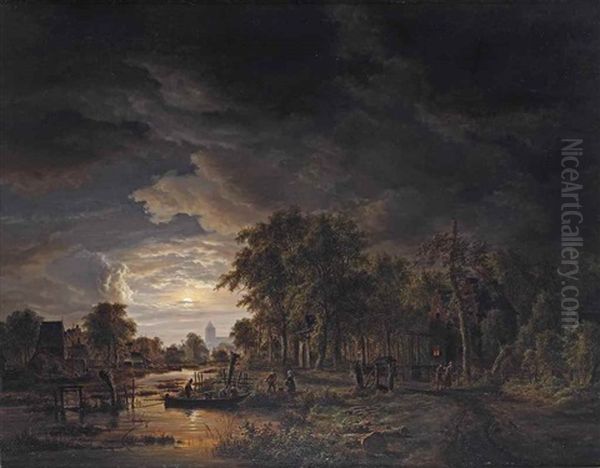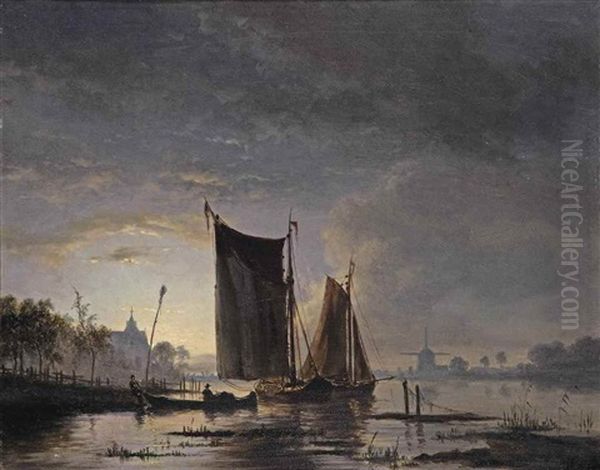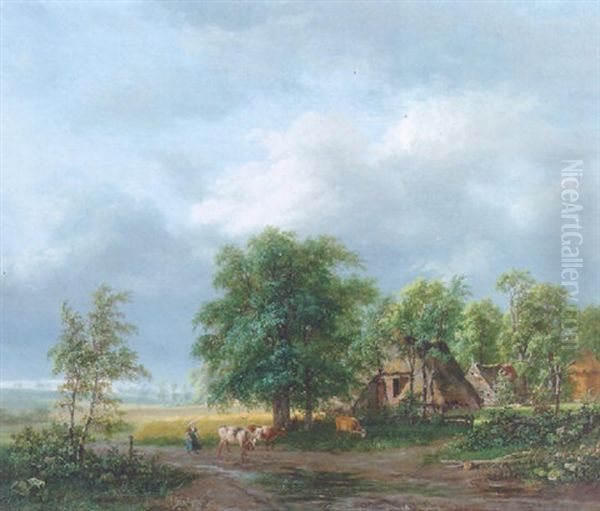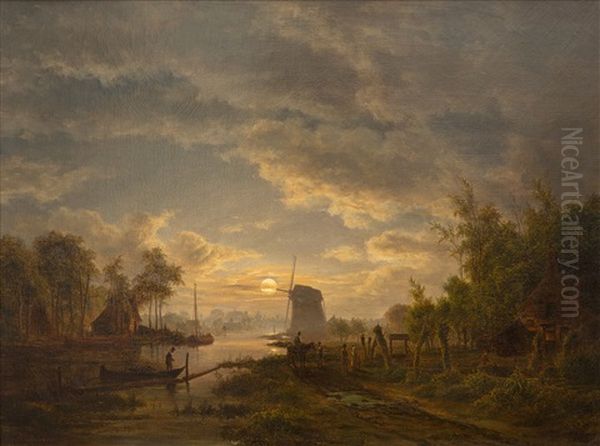
Jacobus Theodorus Abels (1803-1866) stands as a notable figure in the rich tapestry of 19th-century Dutch art. An accomplished landscape painter, he carved a distinct niche for himself with his evocative depictions of moonlit scenes, a specialization that resonated with the Romantic sensibilities of his era. Born in the bustling city of Amsterdam and passing away in the quieter environs of Abcoude, Abels's life and career reflect the artistic currents and personal connections that shaped Dutch painting during a period of renewed national pride and artistic exploration. His work, characterized by a subtle interplay of light and shadow, captures the serene, often melancholic beauty of the Dutch countryside under the ethereal glow of the moon.
Early Life and Artistic Formation
Jacobus Theodorus Abels was born in Amsterdam in 1803, a city with a storied artistic heritage that had been the heart of the Dutch Golden Age of painting two centuries prior. This environment undoubtedly provided an ambient inspiration for a young, aspiring artist. His formal artistic training commenced under the tutelage of Jan van Ravenswaay (1789-1869), a respected painter known for his landscapes with cattle, and a member of the Royal Academy of Art in Amsterdam. Van Ravenswaay himself was part of a generation seeking to revive the Dutch landscape tradition, looking back to masters like Paulus Potter and Aelbert Cuyp for inspiration, while infusing their work with contemporary sensibilities.
Under Van Ravenswaay, Abels would have received a solid grounding in the fundamentals of drawing, composition, and oil painting techniques. The emphasis would likely have been on careful observation of nature, a hallmark of Dutch art, combined with an understanding of how to construct a pleasing and balanced landscape. This early training was crucial in honing his skills and shaping his artistic vision. The artistic milieu of Amsterdam at the time was vibrant, with artists keen to re-establish a distinctively Dutch school of painting after a period of foreign artistic dominance.

In 1826, seeking to broaden his artistic horizons, Abels embarked on a journey to Germany. Such study trips were common for ambitious artists of the period, allowing them to experience different landscapes, artistic traditions, and contemporary movements. Germany, at this time, was a crucible of Romantic thought and art, with painters like Caspar David Friedrich (1774-1840) and Carl Gustav Carus (1789-1869) creating deeply spiritual and emotionally charged landscapes. While direct evidence of Abels's specific encounters or studies in Germany is scarce, the exposure to German Romanticism, with its emphasis on nature's sublime and mystical qualities, likely played a role in refining his own approach to landscape.
Return to the Netherlands and Developing Style
Upon his return from Germany, Abels did not immediately settle in Amsterdam. Instead, he established himself in The Hague, another important artistic center in the Netherlands. This city, with its proximity to the coast and diverse surrounding landscapes, offered ample subject matter. It was during this period that his personal life also took a significant turn; he married the daughter of the esteemed painter Pieter Gerardus van Os (1776-1839). This union brought Abels into a prominent artistic family. P.G. van Os was renowned for his landscapes, cattle pieces, and portraits, continuing a family tradition of artistry (his father was Jan van Os, a painter of flowers and still lifes). This connection would have provided Abels with further artistic camaraderie and potential patronage.
It was in The Hague that Abels began to truly cultivate his signature style, becoming particularly renowned for his moonlit landscapes. This thematic choice distinguished him from many of his contemporaries who might have focused on sunlit pastoral scenes or dramatic seascapes. The depiction of night scenes, or nocturnes, presented unique artistic challenges, requiring a masterful understanding of light, shadow, and tonal values to convey the subtle gradations of light and the mysterious atmosphere of the nocturnal world.
Abels's approach was rooted in the Romantic tradition, which valued emotion, intuition, and the power of nature. His moonlit scenes are not merely topographical records but are imbued with a sense of tranquility, solitude, and sometimes a gentle melancholy. He skillfully used a limited palette, often dominated by cool blues, silvers, and deep indigos, to evoke the specific quality of moonlight on water, trees, and rustic architecture. His brushwork, described as delicate, allowed for nuanced rendering of these effects, creating a soft, atmospheric haze that envelops his subjects.
The Allure of the Nocturne

The nocturne, or night painting, has a long and distinguished history in art, and Abels's specialization places him within this tradition. While 17th-century Dutch Golden Age painters like Aert van der Neer (1603-1677) had excelled in moonlit and winter landscapes, the 19th century saw a renewed Romantic interest in the evocative power of the night. The moon, a recurring motif in Romantic art and literature, symbolized mystery, dreams, introspection, and the sublime.
Abels's fascination with moonlit scenes allowed him to explore these themes. His paintings often feature calm rivers reflecting the lunar glow, quiet villages nestled under the night sky, and solitary boats gliding through shimmering waters. These compositions evoke a sense of peace and timelessness, inviting the viewer into a world removed from the clamor of daily life. The technical execution of these works required considerable skill. Capturing the subtle luminosity of the moon, the deep shadows it cast, and the way it transformed familiar landscapes into something more magical and mysterious was a testament to his observational abilities and his control over his medium.
His contemporaries in Dutch Romanticism, such as Barend Cornelis Koekkoek (1803-1862), often hailed as the "Prince of Landscape Painters," typically focused on majestic, sun-drenched forests or panoramic views. Andreas Schelfhout (1787-1870) was celebrated for his meticulously detailed winter scenes and expansive summer landscapes. While Abels also painted daylight scenes, his moonlit works became his hallmark, offering a different, more introspective vision of the Dutch landscape. Other landscape painters of the era, like Wijnand Nuijen (1813-1839), who died young, brought a more dramatic and sometimes turbulent Romanticism to their work, influenced by French trends.
Representative Works and Their Characteristics
Several of Jacobus Theodorus Abels's works exemplify his mastery of the moonlit genre and his broader landscape capabilities. Among his most recognized pieces is "A Moonlit Village by a River," painted around 1855. This oil on panel, measuring 74 cm by 96 cm, showcases his characteristic style. The composition likely features a serene village scene, with cottages and perhaps a church spire silhouetted against a moonlit sky, the light reflecting gently on the surface of an adjacent river. Such a work would emphasize the quietude of rural life, transformed by the ethereal quality of moonlight.

Another significant painting is "Boats on a Moonlit River." This smaller oil on panel, measuring 22.5 cm by 28.5 cm, demonstrates his ability to create impactful scenes even on a more intimate scale. The focus on boats navigating a river under the moon is a recurring theme, allowing for explorations of reflection and the interplay of light on water. This particular piece was sold at a Neumeister Kunstauktionen sale in Munich in 2008, indicating the continued market interest in his work.
The Rijksmuseum in Amsterdam, the premier national museum of the Netherlands, holds several of Abels's paintings, attesting to his historical significance. These include "Fir Grove with Cattle," "Wood Landscape," and "View of the Downs." While not all of these are necessarily nocturnes, they demonstrate his broader skills in landscape painting, capturing the varied topography and atmosphere of the Dutch countryside. The inclusion of cattle in "Fir Grove with Cattle" also shows an engagement with a pastoral tradition popularised by artists like Paulus Potter (1625-1654) in the Golden Age and continued by his teacher Jan van Ravenswaay and father-in-law P.G. van Os.
A work titled "Bauernhof" (Farmhouse) is noted as a collaborative effort with Pieter Gerardus van Os, his father-in-law. This collaboration highlights the close-knit nature of artistic families and communities during this period. Such joint works often combined the strengths of different artists. Given P.G. van Os's proficiency with animal and figure painting within landscapes, it's plausible he contributed these elements to a scene composed by Abels.
Other works that have appeared on the art market, such as "Hochgebirgslandschaft mit Jägern in Abendlicht" (High Mountain Landscape with Hunters in Evening Light) and "Figures in a river landscape," suggest a broader thematic range, including scenes that might reflect his travels in Germany or more conventional landscape compositions. The "evening light" in the former title again points to his interest in specific lighting conditions beyond broad daylight.
Abels in the Context of Dutch Romanticism
The early to mid-19th century in the Netherlands witnessed a resurgence in painting, often termed Dutch Romanticism. This movement was characterized by a renewed appreciation for the national landscape, a sense of historical pride, and an emphasis on mood and atmosphere. Artists sought to capture the unique beauty of their homeland, from its flat polders and winding rivers to its dense forests and expansive skies.

Jacobus Theodorus Abels was an active participant in this artistic climate. His choice to specialize in moonlit landscapes aligned perfectly with Romantic ideals, which favored the picturesque, the sublime, and the emotionally resonant. His contemporaries included some of the most celebrated names in Dutch art of the period. Barend Cornelis Koekkoek, for instance, achieved international fame for his meticulously rendered and often idealized forest scenes and panoramic landscapes, often bathed in a warm, golden light. Andreas Schelfhout was a master of winter landscapes, capturing the crisp air and frozen waterways with remarkable precision, but also painted summer scenes and seascapes.
Other notable figures included Johannes Bosboom (1817-1891), who became renowned for his atmospheric church interiors, capturing the play of light through stained glass windows, and Cornelis Springer (1817-1891), who excelled in detailed and picturesque townscapes. While their subject matter differed, these artists shared a commitment to skilled craftsmanship and an aim to evoke a particular mood or feeling in their work. The Hague School, which emerged in the latter half of the 19th century with artists like Jozef Israëls (1824-1911), Anton Mauve (1838-1888), and the Maris brothers (Jacob, Matthijs, and Willem), would build upon this Romantic foundation, moving towards a more realistic and often more somber depiction of Dutch life and landscape, emphasizing atmosphere through looser brushwork and tonal harmonies. Abels's work can be seen as a bridge, rooted in Romantic traditions but with a keen observational eye that foreshadowed later developments.
The influence of 17th-century masters was pervasive during this period. Artists like Jacob van Ruisdael (c. 1629-1682) and Meindert Hobbema (1638-1709) were revered for their powerful and evocative landscapes, and 19th-century painters often studied their techniques and compositions. Abels, in his own way, continued this legacy, adapting it to the sensibilities of his time. His focus on the specific atmospheric effects of moonlight was a personal interpretation of the enduring Dutch fascination with light and landscape.
The Van Os Artistic Dynasty
The marriage of Jacobus Theodorus Abels to a daughter of Pieter Gerardus van Os integrated him into a significant artistic lineage. P.G. van Os was a highly respected artist in his own right, known for his landscapes often featuring cattle, a subject he excelled at. He was the son of Jan van Os (1744-1808), a painter of lush flower still lifes and marine scenes, and the brother of Georgius Jacobus Johannes van Os (1782-1861), also a flower painter, and Pieter Frederik van Os (1808-1892), who painted animals and military subjects.
This family connection would have provided Abels with a supportive artistic environment, opportunities for collaboration, and access to a network of patrons and fellow artists. The Van Os family exemplified the way artistic skills and reputations were often passed down through generations in the Netherlands. P.G. van Os himself was influenced by 17th-century Dutch masters like Paulus Potter, as well as French animal painters. His work, like Abels's, contributed to the revival of Dutch painting in the 19th century. The collaboration on "Bauernhof" is a tangible example of their artistic interaction.
Later Years, Death, and Legacy
Jacobus Theodorus Abels continued to paint throughout his life, primarily focusing on the landscapes that had become his specialty. He eventually moved from The Hague and passed away in Abcoude, a small town near Amsterdam, in 1866, at the age of 63. By the time of his death, the Dutch art scene was beginning to shift towards the more naturalistic and impressionistic styles of the Hague School, but the Romantic tradition to which Abels belonged had laid crucial groundwork.
His legacy is primarily that of a skilled and sensitive painter of moonlit landscapes. While perhaps not as widely known internationally as some of his Dutch contemporaries like Koekkoek or Schelfhout, Abels holds a respected place in the history of Dutch art. His works are valued for their technical proficiency, their evocative atmosphere, and their contribution to the Romantic landscape tradition. The presence of his paintings in the Rijksmuseum and their appearance in art auctions attest to their enduring appeal and historical importance.
Art historians recognize Abels for his distinctive focus. In an era where many landscape painters celebrated the vibrancy of daylight, Abels explored the more subdued and mysterious beauty of the night. His ability to capture the subtle nuances of moonlight and create scenes of profound tranquility and introspection marks him as a specialist with a unique vision. He contributed to the rich diversity of 19th-century Dutch painting, reminding viewers of the poetic potential inherent in the nocturnal world.
The Enduring Appeal of Abels's Art
The art of Jacobus Theodorus Abels continues to resonate with audiences today for several reasons. His moonlit scenes possess a timeless quality, evoking universal emotions of peace, solitude, and wonder. In a fast-paced modern world, these paintings offer moments of quiet contemplation. The technical skill displayed in rendering the subtle effects of moonlight and shadow remains admirable, showcasing a deep understanding of his craft.
Furthermore, Abels's work provides valuable insight into the Dutch Romantic movement and the broader artistic concerns of the 19th century. His paintings reflect the era's fascination with nature, emotion, and the picturesque. As a specialist in nocturnes, he carved out a particular niche that, while perhaps less common, was deeply aligned with the Romantic spirit that also found expression in the works of international figures like the German Caspar David Friedrich or, in a different medium, the nocturnes in music by composers like Frédéric Chopin.
His connection to other significant artists of his time, through his teacher Jan van Ravenswaay and his father-in-law P.G. van Os, situates him firmly within the artistic networks that fostered the development of Dutch art. Jacobus Theodorus Abels may not have sought the grand, heroic landscapes of some of his peers, but in his chosen realm of the moonlit Dutch countryside, he achieved a quiet mastery and left behind a body of work that continues to enchant and inspire. His paintings are a gentle reminder of the beauty that can be found in the stillness of the night, captured by an artist with a keen eye and a poetic soul.